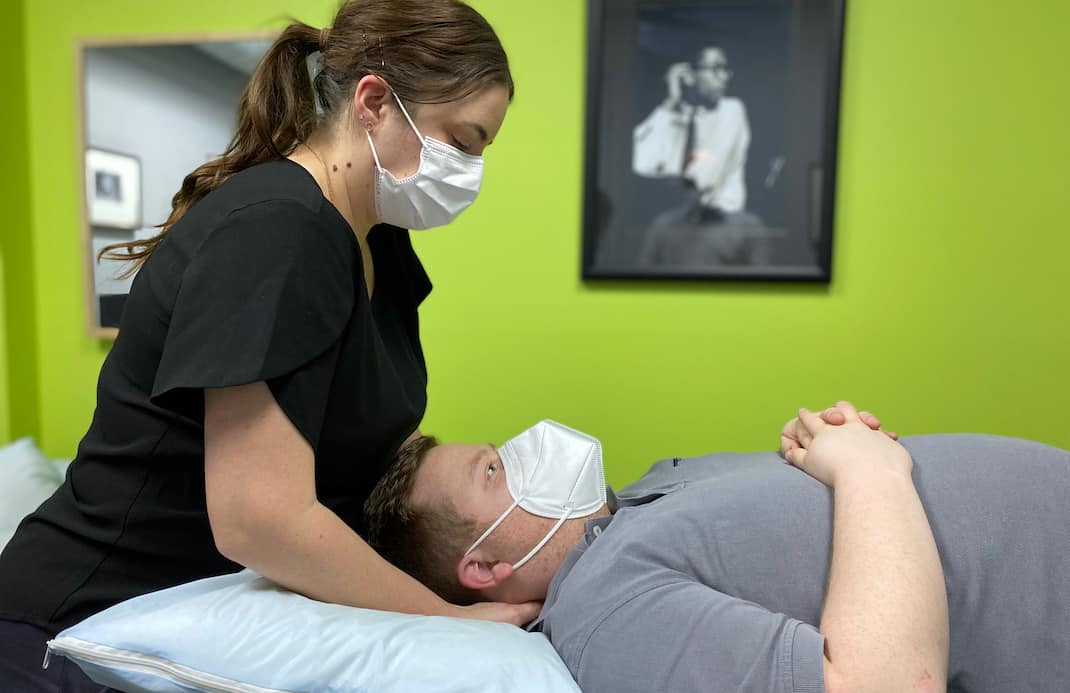A good diet for osteoarthritis isn’t just about losing weight.
An anti-inflammatory diet has beneficial effects on improving low level inflammation, which is now known to be a key part of osteoarthritis.
This should be part of the first line treatment of osteoarthritis. And losing weight might be a nice side-effect!
For the sceptics…
It wasn’t that long ago that I would have questioned the idea of your diet helping pain. I might have even dismissed it as being too ‘fringey’ or someone just trying to sell something. However, I am happy to say that I am enlightened!
This is not pseudo-science. There is plenty of evidence to back up the notion that what you eat can have an effect on inflammatory factors in your body.
There is no one selling a product here! We are not talking about supplements, latest fad diets or so-called super foods. Or getting a washout.
Instead, we are advocating the right fresh foods, and simple, good choices.
But you’re physios! Why are you talking about diet?
As physios, it is not our place to give specific dietary information. That should come from a qualified dietician or your GP.
However, you don’t need to be a dietician to make solid general recommendations as laid out in publicly available guidelines from reputable sources.
We promote the idea of people actively taking on their problems. Especially where there are evidence-based solutions that people can implement themselves. This is always better than being heavily reliant on medication, surgery, or passive treatments.
We feel that it is really important to draw people’s attention to their diet as an important aspect of helping themselves. Diet works hand in hand with exercise and strengthening and makes up the first line treatment for osteoarthritis.
It has become increasingly evident that gut health is related to the function of many systems in your body. When you read evidence of gut microbiome being found in the cartilage of an osteoarthritic joint, it makes it easier to see the direct relationship between the gut biome and osteoarthritis!
Inflammation – ‘are you with me or against me?’
Inflammation is an important process in your body. It is part of your basic immune system response to protect you against all kinds of things – infection, foreign objects, stings, and injury. Without it, you wouldn’t heal after a sprained ankle or fight an infection from a splinter.
There is an ongoing balance in your body between molecules that promote inflammation and molecules that dampen inflammation. In other words, a balance between pro-inflammatory and anti-inflammatory influences.
Get this – the modern understanding of osteoarthritis is not about ‘bone on bone’ or ‘wear and tear’. It is about a low level inflammatory response in your body (plus other things, but we’ll focus on the inflammation and diet aspect here).
And you have full control over what you put in your cakehole.
And what you put in your cakehole – what you fuel your body with – has an effect on fanning this low level inflammation.
Couple an anti-inflammatory diet with the right kind of exercise* and you are on the way to optimising your pro vs anti inflammatory balance. (How much exercise, what kind of exercise and how often to exercise is another story – you can get more info on that below).
Spinoffs from an Anti-Inflammatory Diet
If you couple an anti-inflammatory diet with exercise for your osteoarthritis, you have the potential to:
- reduce your weight
- reduce your pain and
- have more energy
- lower blood pressure
- lower your risk of other health problems eg heart disease, depression, cerebrovascular disease and more.
OK, so what makes up an ‘Anti-Inflammatory Diet’?
In a nutshell, it consists of:
- Fresh vegetables (all kinds) – aim for a variety of types and colours (a rainbow of veggies provides phytonutrients) with a minimum of four to five servings per day – especially dark, leafy greens (spinach, kale, Asian greens) broccoli and cauliflower, brussel sprouts, beetroot
- Whole pieces of fruit (not juice that strips them of fibre) – three to four servings per day is a good amount for most people, especially berries and cherries
- Fatty fish – such as salmon, trout, sardines, mackerel & tuna
- Herbs & spices – turmeric, ginger, basil, oregano, thyme, cinnamon etc.,
- Healthy fats – extra virgin olive oil is the best option, avocado oil and the fats found in seeds, nuts, fish
- Nuts/seeds – such as walnuts, cashews, almonds, pistachios, pine nuts, chia, hemp
- Whole grains – brown rice, amaranth, buckwheat, and quinoa
- Legumes/beans – especially black beans, black-eyed peas, chickpeas, lentils, red kidney
- Drinks – water, green tea and organic coffee in moderation
Avoid these inflammatory / processed foods
- Processed meats – sausages and cold cut meats – ham, salami etc.
- Refined sugars – found in soft drinks, cookies, cake, lollies, ice cream, some breakfast cereals
- Trans fats – found in deep fried foods, fast foods, commercially baked goods
- Processed snack foods – such as chips and crackers
- Gluten, white bread & pasta & too many carbohydrates
- Soybean oil and vegetable oil
- Alcohol in excessive quantities
This information is taken directly from the Arthritis NSW site. Their page on the anti-inflammatory diet also has some great ideas for substitute meals.
They also say:
‘The Mediterranean Diet is considered one of the healthiest diets and is also a good go-to for an anti-inflammatory diet. It also includes dairy such as yoghurt and cheese, which is good for calcium intake to prevent osteoporosis.
Eggplant, tomatoes, capsicum and potatoes are central to Mediterranean cuisine. Some people believe they trigger arthritis flares, but there’s limited scientific evidence to support this theory. Some people may react as they have a food sensitivity to these vegetables. If you react consider replacing these vegetables with sweet potatoes, cauliflower or mushrooms.’
Another great page is on the Arthritis Foundation site, which you can access here. This goes into more detail with how much of each food and how they help.
The Anti-Inflammatory Diet – take home messages
Don’t underestimate the importance of your diet if you have osteoarthritis. The aim is not just weight loss. The weight component may actually be less important that previously thought. The aim is about reducing your low level inflammation in your body.
This is something that only you can control. You will supercharge the effects of the exercise that you do to help with your arthritis by giving yourself the right energy sources and reduce your pain by reducing this low level inflammation.
Please note: this is general advice only. If you aren’t sure about any of this information, or you have specific requirements eg if you are diabetic or on medication, don’t hesitate to consult your GP or a dietician.
Related articles:
If you want to read more, Kimberley wrote a blog about food and pain way back in 2017. She is very enlightened! You can read it here.
Here is a recent blog on the role of weight loss and osteoarthritis. It expands on the role of inflammation and pain, and how weight seems to be less important compared to altering the low level inflammation.
PS – What is the ‘right exercise*’?
The right exercise means the right kind of exercise for you and the right dosage for you. This is determined on an individual basis.
In case you were wondering what kind of exercise is the best for knee and hip OA, you might find this page interesting.
It describes the GLA:D programme that we run here at Adelaide West Physio + Pilates.
GLA:D is evidence-based and it is fair to say that the results in the research are pretty good.
Anecdotally, from the people that have gone through the programme with us, the results have been fantastic.
From the data that GLA:D are keeping, there is an average of 32% pain reduction from the hundreds of thousands of people who have gone through the programme.
If you have knee or hip OA and you are interested in finding out more about GLA:D and how it can change your life, Kimberley, Lisa, Maddie or Lachlan would be very happy to talk more with you about it.

Organise A FREE Physio Phone Consult
Get some FREE ADVICE, find out if physiotherapy can help your problem and give you pain relief, and importantly, find out if we are the right physios for you!
Alternatively, you can organise a free 15 minute assessment in person at the clinic.
To Organise a Phone Call with a Physio
- Option one: Click on the ‘Online Bookings’ button at the top of the page, then choose the ‘Free Physio Phone Consult’ option and find a time that suits you.
-
Option two: Call us on
8356 1000 and organise a time for a call back from one of our physios for a discussion with you about your problem.

















